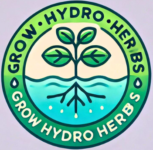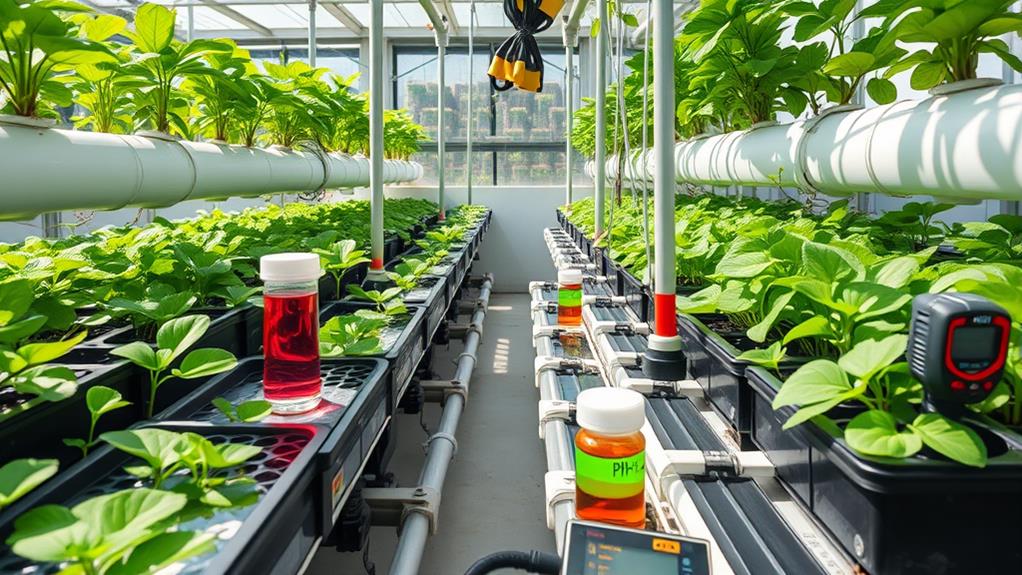Introduction to DO in Hydroponics
Dissolved oxygen, or DO, is an important element in hydroponics. It refers to the oxygen that gets mixed into the nutrient solution your plants rely on.
Why is this so crucial? Well, just like we need air to breathe, plants need oxygen for their growth and health. When the DO levels are ideal—between 6 to 8 mg/L—plants thrive. But if the levels drop below 5 mg/L, it can stress them out and slow down their growth.
On the flip side, having higher levels of DO can be a game-changer. It helps plants absorb nutrients more quickly, which means their roots grow stronger. This makes them more resilient and better able to fight off diseases.
To keep those DO levels where they need to be, consider using aeration techniques. Options like air stones or pumps can help mix oxygen into the nutrient solution effectively.
Dissolved oxygen (DO) is essential for successful hydroponic gardening. It ensures better nutrient absorption, prevents root diseases, and promotes healthy plant growth. Learn how to maintain optimal DO levels and keep your plants thriving.
GrowHydroHerbs TLDR
- Optimal DO Levels: Maintaining dissolved oxygen (DO) levels between 6-8 mg/L is ideal for healthy plant growth.
- Nutrient Absorption: Higher DO levels improve nutrient uptake, leading to stronger roots and faster growth.
- Disease Prevention: Adequate DO levels help prevent root diseases, such as root rot caused by pathogens like Pythium.
- Temperature Control: Cooler nutrient solutions hold more oxygen, enhancing plant health.
- Aeration Methods: Using air pumps, air stones, or hydrogen peroxide can help maintain proper DO levels.
By taking the time to monitor and manage these levels, you’ll not only ensure healthier plants but also boost your crop yields. Understanding how to maintain dissolved oxygen in your hydroponic system is a key step towards success!
Understanding Dissolved Oxygen
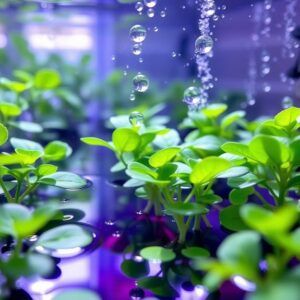
In hydroponics, knowing about dissolved oxygen (DO) is really important for keeping your plants healthy and helping them grow. So, what’s dissolved oxygen? It’s simply the oxygen that’s mixed into your nutrient solution. This oxygen is crucial because it supports plant respiration, which is how plants breathe.
For the best results, you want the DO levels to be around 6 to 8 mg/L. If the oxygen levels drop below 5 mg/L, your plants might start feeling stressed, and they could become more vulnerable to diseases.
One thing to keep in mind is that temperature has a big impact on DO levels. Warmer water can’t hold as much oxygen as cooler water. So, it’s a good idea to keep your nutrient solution cool. This way, it can retain more oxygen.
When DO levels are high, plants can take in nutrients better, grow stronger roots, and thrive overall. In fact, research shows that DO levels over 20 mg/L can really boost your crop yields.
To help your plants flourish, make it a habit to check the dissolved oxygen levels regularly. You can use aeration methods, like air pumps or even adding a bit of hydrogen peroxide, to keep your nutrient solution well-oxygenated.
Importance of Dissolved Oxygen
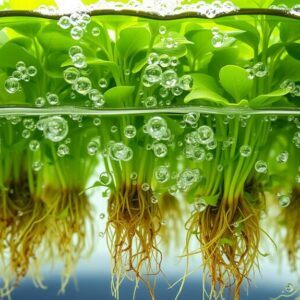
Dissolved oxygen is super important for your success in hydroponics. It plays a big role in helping your plants absorb nutrients and develop strong root systems.
When the levels of dissolved oxygen are just right, your plants can handle stress better and are less likely to get sick.
By making sure there’s enough oxygen in the water, you’re setting your plants up for healthy growth and bigger harvests.
Enhances Nutrient Uptake
To help your plants grow their best in a hydroponic system, it’s super important to keep the dissolved oxygen (DO) levels just right. Aim for more than 5 mg/L, but shooting for over 8 mg/L is even better.
So, why is adding oxygen to your nutrient solution so crucial? Let’s break it down:
- Helps roots breathe: Just like us, roots need oxygen to function properly. When they get enough, they can soak up nutrients more effectively.
- Reduces stress on roots: If there’s enough dissolved oxygen, your plants are less likely to struggle and grow at a snail’s pace.
- Speeds up growth: Higher levels of oxygen, around 20-30 mg/L, can really help your plants grow faster, especially when the temperatures are cooler.
- Keeps bad bacteria away: Good oxygen levels can help prevent harmful bacteria from taking over, which is great for your plants’ health.
By focusing on these oxygen levels, you’re giving your plants a strong foundation to flourish.
Promotes Root Health
Keeping the oxygen levels in your hydroponic system high is crucial for healthy roots. Ideally, you want dissolved oxygen (DO) levels to be above 8 mg/L. This is important because it helps plant roots breathe properly, which boosts their ability to take in nutrients and grow efficiently.
When you maintain high DO levels, you’re creating a thriving environment for roots. This not only helps them flourish but also lowers the chances of root rot caused by harmful pathogens like Pythium and Fusarium.
On the flip side, if the DO levels drop too low, it can lead to a lack of oxygen, which is bad news for your plants. Hypoxic conditions can trigger root diseases and make plants stressed, leading to lower yields.
Studies show that keeping DO levels between 20-30 mg/L can significantly speed up growth and improve root health.
To ensure your plants stay healthy, it’s important to regularly check the DO levels and use good aeration methods. This will help keep oxygen levels high and your plants thriving.
Boosts Plant Resilience
In hydroponics, having plenty of dissolved oxygen (DO) is super important for making plants stronger and healthier. When you keep DO levels above 8 mg/L, you’re not just helping the roots; you’re also giving plants a better chance to soak up nutrients. This is crucial because strong root systems are the backbone of healthy plants.
Here’s how higher DO levels can make a difference:
- Better nutrient absorption: When there’s a lot of oxygen, the roots can grab nutrients more easily.
- Stronger against germs: Higher DO levels can help keep root rot and diseases from nasty organisms at bay.
- Healthier roots: Sufficient oxygen helps roots breathe, which leads to sturdier root structures.
- Faster growth: Studies show that ideal DO levels can really boost the overall growth of your hydroponic plants.
Methods to Increase DO Levels
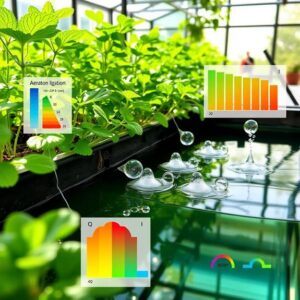
To keep your hydroponic system healthy and flourishing, it’s essential to raise the levels of dissolved oxygen (often called DO).
There are several effective methods you can use.
First, consider aeration techniques. This means adding air to the water, which helps your plants breathe better.
Next, adjusting the temperature of your nutrient solution can also help. Warmer water holds less oxygen, so keeping it at the right temperature is important.
Another great strategy is to create movement in the water. This can be achieved by using tools like water pumps or air stones. These devices circulate the water, which not only helps mix in oxygen but also keeps nutrients evenly distributed.
Additionally, you might want to look into oxygen-infused solutions. These products can give your plants an extra boost of oxygen.
By using these methods, you’ll ensure that your plants receive the oxygen they need to grow strong and healthy.
Happy gardening!
Aeration Techniques
Aeration techniques play a crucial role in boosting the levels of dissolved oxygen (DO) in hydroponic systems. Keeping your DO levels above 5 mg/L is essential for your plants to flourish. This improves their ability to absorb nutrients and enhances their overall health.
Here are some simple and effective ways to oxygenate your nutrient solution:
- Air Pumps and Diffusers: An air pump paired with diffusers can work wonders. They help introduce air into your nutrient solution, significantly raising the DO levels.
- Hydrogen Peroxide: Adding a bit of hydrogen peroxide can also improve oxygen levels. It acts as an extra source of oxygen and can help prevent root rot, which is a common issue in hydroponics.
- Rapid Mixing: Stirring or mixing your nutrient solution is another easy method. This physical action helps incorporate air, further increasing the dissolved oxygen.
- Venturi Injectors: These nifty devices create a vacuum effect. They pull air into the nutrient solution, enriching it with oxygen.
It’s important to keep a close eye on your DO levels. Aim for a range of 6-8 mg/L for the best growth results.
Also, using reflective materials in your setup can help maintain water quality. This keeps your nutrient solutions cooler, which allows for better oxygen retention.
Nutrient Solution Temperature
Keeping the right temperature in your nutrient solution is super important for your plants. Why? Because it helps ensure that there’s enough dissolved oxygen (DO) for them to thrive.
When the water gets too warm, especially over 27°C, it doesn’t hold as much oxygen. This can create hypoxic conditions, which are bad news for your plant roots and overall health.
To keep your plants happy and healthy in a hydroponic system, you should aim to keep the nutrient solution below 24°C. Cooler water means more oxygen, which helps your plants absorb nutrients better and grow stronger.
One great way to cool down your nutrient solution is by using chillers. These handy devices can really help lower the temperature, which in turn boosts the oxygen levels.
Another tip? Think about adding reflective materials to your greenhouse. These can help keep the heat at bay, so your nutrient solution stays cooler.
It’s also a good idea to regularly check the temperature of your nutrient solution. Make sure it stays within that ideal range. If it goes above 27°C, your plants might struggle because of the lower oxygen.
Water Movement Strategies
Boosting dissolved oxygen (DO) levels in your hydroponic system can make a big difference in how your plants grow. When you improve the way your nutrient solution moves, you’re also giving your plants more oxygen, which helps them thrive and become stronger.
Here are some simple and effective strategies to consider:
- Add air stones: These handy little devices create tiny bubbles that increase the surface area for oxygen to mix with the water. This means more oxygen for your plants!
- Use a Venturi Oxygen Injector: This tool pulls air into the nutrient solution. It works like a vacuum, making it easier for oxygen to blend into the water.
- Cycle air blowers or compressors: If you switch between these machines and air stones in your batching tanks, you can keep DO levels steady. This is especially helpful for drip systems that don’t run continuously.
- Cool down your nutrient solution: Lower temperatures can really help boost DO levels. The cooler the water, the more oxygen it can hold.
By using these water movement strategies, you can keep the dissolved oxygen levels just right in your hydroponic systems. This will help your plants not only survive but really flourish, maximizing their ability to take in nutrients.
Remember, having enough dissolved oxygen is crucial. It prevents low-oxygen conditions that can slow down your plants’ growth.
Use of Air Pumps
Adding air pumps to your hydroponic system can really boost the health and growth of your plants. These pumps play a crucial role by pumping oxygen directly into the nutrient solution, which increases the levels of dissolved oxygen (DO). This is important because when your plants have enough oxygen, they can take up nutrients better and thrive overall.
By using air stones with your air pumps, you can create tiny bubbles that spread throughout the nutrient solution. This not only increases the oxygen saturation but also helps to create the right conditions for healthy roots. Keeping your air pumps running regularly ensures that the DO levels stay above 5 mg/L, which is essential for preventing root diseases.
Additionally, air pumps help to mix the nutrient solution, so oxygen gets distributed evenly throughout the system. If you choose larger, more powerful air pumps, you can even raise the DO levels to 8 mg/L or more. This extra oxygen not only supports strong plant growth but also helps your plants deal with stress and resist diseases.
In short, investing in good air pumps is key to having a successful hydroponic garden. They provide the oxygen that your plants need to flourish and stay healthy.
Oxygen-Infused Solutions
Boosting the amount of dissolved oxygen (DO) in your hydroponic system can really help your plants thrive. One great way to do this is by using oxygen-infused solutions. When your roots get the oxygen they need, they can soak up nutrients much better, which leads to healthier plants.
Here are some easy ways to raise those DO levels:
- Hydrogen Peroxide: This handy solution not only increases oxygen levels but also helps prevent root rot by adding extra oxygen to the mix.
- Venturi Injectors: By adding venturi injectors to your nutrient delivery system, you can mix air right into your nutrient solution. This boosts the overall DO levels, making a big difference for your plants.
- Air Stones or Diffusers: These tools can help improve oxygen levels too. However, keep in mind that their effectiveness might be limited by the amount of CO2 in the air of your greenhouse. For even better results, consider using pure oxygen.
- Cycling Nutrient Solution: Regularly moving your nutrient solution through sprinklers creates tiny water jets, which improves oxygenation and helps keep DO levels up.
Using these methods can lead to stronger, healthier plants. So go ahead, give them a try!
Plant Root Considerations
Keeping the right amount of dissolved oxygen (DO) in your hydroponic system is really important for strong root growth. When you’re growing plants in nutrient solutions, it’s crucial to ensure that the dissolved oxygen stays above 5 mg/L. Ideally, you want it to be over 8 mg/L. This helps your plants develop healthy roots, which are essential for absorbing nutrients and coping with stress.
To boost the DO levels, you can use air pumps and air stones. These tools add oxygen directly into the nutrient solution. Another option is hydrogen peroxide. When it breaks down, it releases oxygen, which can help increase DO levels.
If you’re using the Nutrient Film Technique (NFT), it naturally improves oxygen levels too. This method allows the nutrient solution to flow and cascade, exposing it to air and preventing stagnation.
Venturi oxygen injectors are also a great addition to your system. They not only oxygenate the nutrient solutions but also help to remove waste gases. This results in healthier roots for your plants.
Remember to keep a close watch on the DO levels, especially in warmer greenhouse settings. Higher temperatures can reduce the amount of oxygen that can dissolve in water.
Effects of Low Oxygen Levels
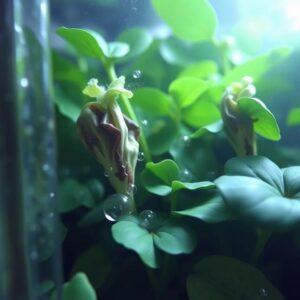
When the oxygen levels in your hydroponic system start to drop, your plants can really suffer.
You might notice that their growth slows down, and they just don’t seem to thrive like they should.
One major issue that arises is their ability to take up nutrients. Without enough oxygen, it becomes difficult for them to absorb what they need to grow strong and healthy.
On top of that, low oxygen levels can create a breeding ground for diseases. This means that the risk to your entire crop increases, and that’s something you definitely want to avoid.
Plant Growth Inhibition
In hydroponics, having low levels of dissolved oxygen (DO) can really hurt your plants. When oxygen levels fall below 5 mg/L, your plants can start to feel a lot of stress at their roots, and that can lead to a whole bunch of problems.
First off, without enough oxygen, plants can’t take in nutrients properly. This means they won’t grow as strong or as healthy as they should. Plus, low oxygen creates a perfect spot for nasty organisms that thrive without oxygen, which can lead to root rot. That’s a serious threat to your entire crop!
Here are some important things to know about low DO:
- Root stress: When the oxygen is low, roots have a tough time doing their job, which can cause the plants to grow slowly or not at all.
- Nutrient absorption: Plants need oxygen to absorb nutrients effectively. Without it, their overall health can take a big hit.
- Anoxic conditions: If oxygen levels drop below 0.5 mg/L, plants can lose their entire root system. This can make it impossible for them to survive.
- Increased disease risk: Low DO levels are a breeding ground for harmful organisms like Pythium and Fusarium. These can make your plants even sicker.
To keep your plants healthy and strong, it’s really important to maintain dissolved oxygen levels above 8 mg/L. This helps them grow well and builds their strength against any challenges.
Nutrient Uptake Reduction
Low levels of dissolved oxygen (DO) can really mess with how plants absorb nutrients in hydroponic systems. When the oxygen dips below 5 mg/L, you could start noticing some serious issues. The roots mightn’t grow as they should, which can put a lot of stress on your plants.
Without enough dissolved oxygen, the helpful aerobic bacteria that break down and absorb nutrients in the root zone struggle to survive, making the situation even worse.
As the oxygen levels keep falling—especially below 2 mg/L—you face the risk of completely harming the roots. This can severely limit the plants’ ability to take in essential nutrients, which could lead to losing your crops.
To make matters worse, when there’s a high biological oxygen demand (BOD) in your nutrient solution, it competes with your plants for the oxygen they desperately need, creating even more challenges for nutrient uptake.
To keep your plants breathing and growing at their best, it’s crucial to maintain DO levels above 8 mg/L. If they dip below this mark, you may start seeing nutrient deficiencies and your crops mightn’t perform well.
That’s why regularly checking the dissolved oxygen levels in your hydroponic system is vital. It ensures that your plants can thrive and effectively absorb nutrients.
Disease Susceptibility Increase
Keeping dissolved oxygen (DO) levels above 5 mg/L is really important for your hydroponic plants. Why? Because low DO levels can lead to an increase in disease susceptibility among your plants.
When oxygen levels drop, it creates a perfect environment for harmful organisms like Pythium and Fusarium to thrive. These nasty root diseases can quickly cause root rot and endanger your whole crop.
To help keep your plants healthy, here are some key points to consider:
- Higher risk of root diseases: When DO is low, it encourages the growth of harmful pathogens that love low-oxygen conditions.
- Fewer good bacteria: Without enough oxygen, beneficial bacteria that help fight off diseases can’t grow as well.
- Weaker plants: If oxygen levels fall, your plants become more vulnerable and less able to resist infections.
- Possible crop failure: If low oxygen levels persist for too long, you could lose your entire hydroponic system.
By paying attention to these factors, you can help ensure your plants stay strong and healthy.
Keeping those oxygen levels up is key to preventing disease and promoting a thriving hydroponic garden!
Monitoring Dissolved Oxygen Levels
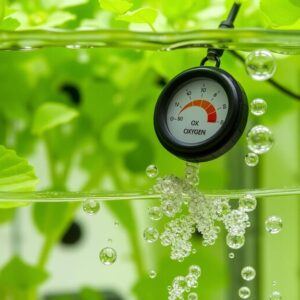
Keeping an eye on dissolved oxygen levels is super important if you want your hydroponic system to thrive.
There are a few ways to measure these levels, and one of the best tools you can use is a DO meter. This handy device helps you make sure your plants are getting the oxygen they need to grow strong and healthy.
By regularly checking these levels, you can quickly make changes when necessary. This way, you create the perfect environment for your plants to flourish.
Importance of DO Monitoring
Understanding the importance of dissolved oxygen (DO) levels in hydroponics is key to ensuring your plants grow strong and healthy.
But just knowing about it isn’t enough. You also need to keep an eye on those DO levels regularly. Monitoring these levels is essential for your plants to truly thrive and helps you steer clear of any potential issues. When oxygen levels drop too low, your plants can suffer from stress, grow more slowly, or even experience root damage.
Here are some reasons why you should make it a priority to check dissolved oxygen levels:
- Boosting Growth: Keeping the DO levels above 6 mg/L—ideally around 8 mg/L—can really help your plants absorb nutrients better and stay healthy.
- Avoiding Low Oxygen: By checking regularly, you can prevent hypoxia, which is when oxygen levels get too low. This is especially important during hot weather when the oxygen in water can dissolve less.
- Adjusting Aeration: Monitoring DO levels lets you tweak your aeration methods. This way, you can ensure your plants always have the oxygen they need to grow.
- Fighting Diseases: Healthy DO levels help your plants resist diseases better, leading to a stronger and more resilient hydroponic setup.
In short, keeping track of dissolved oxygen isn’t just a good idea; it’s a vital part of caring for your hydroponic plants.
Make it a habit, and you’ll see the difference!
Measurement Techniques Available
To keep your hydroponic plants healthy, measuring dissolved oxygen (DO) levels is really important. One of the best ways to do this is by using portable DO meters, like those made by Hanna Instruments. These handy devices adjust for temperature changes automatically, so you always get accurate readings. For your plants to thrive, aim for DO levels above 5 mg/L, and check them regularly to avoid low oxygen levels that could harm your crops.
Calibration is also essential for getting the right measurements. You can use sensors, such as HORIBA galvanic probes, which need to be calibrated with air and standard solutions. This helps them adapt to the changing conditions in your hydroponic setup, ensuring you get trustworthy data on your DO levels.
Moreover, modern technology is making waves in this field. Tools that incorporate the Internet of Things (IoT) and data analysis are gaining popularity. These advancements allow you to monitor dissolved oxygen continuously, providing real-time updates about how your system is doing.
By using these measurement techniques, you can manage DO levels effectively. This is crucial for helping your plants absorb the nutrients they need to grow strong and healthy in their hydroponic environment.
Regularly checking dissolved oxygen not only supports healthy growth but also helps prevent root diseases and can lead to better crop yields. So, keeping an eye on that oxygen level is key to your gardening success!
Maintaining Optimal Levels
Keeping the right amount of dissolved oxygen (DO) in your hydroponic system is super important for your plants’ health. When you regularly check these levels, you ensure that your nutrient solution is full of oxygen. This boosts your plants’ growth and makes them stronger.
Aim for DO levels that are above 5 mg/L. If the levels drop too low, your plants might struggle because they can’t get the oxygen they need.
Here are some easy tips to help you monitor and maintain those oxygen levels:
- Get a portable dissolved oxygen meter: Tools like the ones from Hanna Instruments are great because they give you accurate readings and adjust for temperature changes.
- Use aeration methods: By adding air pumps and oxygen diffusers, you can increase the oxygen in your nutrient solution.
- Check regularly: Make it a habit to monitor DO levels. This way, you can avoid situations where your plants don’t get enough oxygen, which can hurt both their roots and their overall health.
- Calibrate your equipment often: Keep your monitoring tools in check to make sure they give you correct readings of your dissolved oxygen levels.
How Can Dissolved Oxygen In Hydroponics Help our Plants Grow?
In the world of hydroponics, having enough dissolved oxygen (DO) is super important for the health of your plants.
Think of it this way: when the oxygen levels are high, your plants can grow strong and healthy. They bounce back from stress and thrive, reaching their full potential.
But if the oxygen levels drop too low, your plants can really struggle. Without enough oxygen, they can feel like they’re gasping for breath, which can hold back their growth and overall health.
That’s why it’s essential to keep an eye on the dissolved oxygen levels in your hydroponic system. By regularly checking and managing these levels, you create an environment where your plants can truly shine.
So, remember, striking a good balance of oxygen is key. With the right amounts, your hydroponic garden can flourish like never before!
Questions? We Have Answers.
Get answers to a list of the most Frequently Asked Questions.
